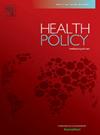提高儿童疫苗接种覆盖率的举措:国际比较
IF 3.4
3区 医学
Q1 HEALTH CARE SCIENCES & SERVICES
引用次数: 0
摘要
儿童疫苗接种率随着时间的推移而波动,并不总是达到世界卫生组织建议的水平。本研究旨在概述各国为提高疫苗接种率而采取的措施。方法我们开发了一个结构化的数据收集模板,由来自欧洲、以色列、美国和加拿大的国家专家完成。专家是通过欧洲卫生系统和政策观察站的卫生系统和政策监测网络确定的。我们接触了来自32个国家的专家,收到了来自22个国家的回复。在模板中,我们要求提供2014年至2019年期间采取的措施。专家们被要求指出干预的类型、目标人群、可能的积极和消极影响以及有效性的证据。这些信息是在2019年9月至2020年1月期间收集的。结果:我们确定了四种主要的干预措施:对未接种者的限制措施、财政激励措施、支持疫苗接种后勤的措施和疫苗接种促进运动。限制性措施通常涉及扩大现有的强制性疫苗接种政策或限制未接种疫苗的儿童参加学前活动。对医疗保健提供者的财政激励显示出一些积极效果。在后勤支持方面,一些国家使用学校作为替代疫苗接种地点,尽管这带来了组织上的挑战。许多国家投资于提高卫生保健专业人员和家长的知识,以鼓励接种疫苗。报告所涵盖的国家实施的大多数举措侧重于交流和知识的增进。然而,关于这些措施对疫苗接种覆盖率的影响的证据有限。本文章由计算机程序翻译,如有差异,请以英文原文为准。
Initiatives to increase childhood vaccination coverage: an international comparison
Background Childhood vaccination rates fluctuate over time and do not always meet the levels recommended by the WHO.
Objective This study aims to provide an overview of measures countries have introduced to increase vaccination rates.
Methods We developed a structured data collection template that was completed by country experts from Europe, Israel, the USA, and Canada. Experts were identified using the European Observatory on Health Systems and Policies’ HSPM (Health Systems and Policy Monitor) network. We approached experts from 32 countries and received responses from 22 countries. In the template we asked for measures introduced between 2014 and 2019. The experts were asked to indicate the type of intervention, the target population, possible positive and negative effects, and evidence on effectiveness. The information was collected between September 2019 and January 2020.
Results We identified four main types of interventions: restrictive measures for the unvaccinated, financial incentives, measures supporting the logistics of vaccination, and vaccination promotion campaigns. Restrictive measures often involved expanding existing mandatory vaccination policies or limiting access to pre-school activities for unvaccinated children. Financial incentives for healthcare providers showed some positive effects. Regarding logistical support, several countries used schools as alternative vaccination sites, though this presented organisational challenges. Many countries invested in improving knowledge among both healthcare professionals and parents to encourage vaccine uptake.
Conclusions Most initiatives implemented in the countries covered focussed on communication and knowledge enhancement. However, there is limited evidence on the impact of these measures on vaccination coverage.
求助全文
通过发布文献求助,成功后即可免费获取论文全文。
去求助
来源期刊

Health Policy
医学-卫生保健
CiteScore
6.40
自引率
6.10%
发文量
157
审稿时长
3-8 weeks
期刊介绍:
Health Policy is intended to be a vehicle for the exploration and discussion of health policy and health system issues and is aimed in particular at enhancing communication between health policy and system researchers, legislators, decision-makers and professionals concerned with developing, implementing, and analysing health policy, health systems and health care reforms, primarily in high-income countries outside the U.S.A.
 求助内容:
求助内容: 应助结果提醒方式:
应助结果提醒方式:


